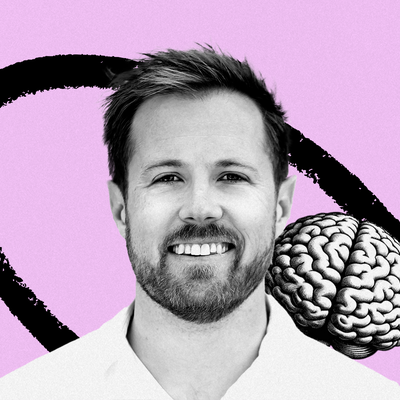
Here's an unresolved question in science that might surprise you: why do thinking, planning, and calculating take effort?
While physical work requires flexing and unflexing muscles, incurring a direct calorie cost, scientists have measured the metabolic costs of hard thinking and found almost no extra calorie consumption compared to the resting brain state [1][2]. So what gives?! Why can mental work be such a chore?
In a 2016 scientific review article, "Dopamine does double duty in motivating cognitive effort," [3] researchers at Washington University in St. Louis present the hypothesis that cognitive effort is simply a matter of opportunity cost: essentially, it’s nature's jury-rigged mechanism to make us leave some mental capacity available to handle survival needs, by making us averse to sinking too much of that brainpower on extended problem-solving or repeatedly fruitless thoughts. Our ancestors may not have figured out how to protect themselves against rising floodwaters if their brains were always occupied testing better ways to weave a basket.
The article proposes an explanation of how the brain strikes a balance between aversion to effort and the competing experience of motivation—dopamine. Dopamine is popularly known as the feel-good chemical released in the brain by things like exercise, our favorite foods, and sex. But it is also a neurotransmitter that scientists have long known to be intricately involved in regulating cognitive effort. Using evidence from fine-grained experiments and advanced brain imaging techniques, the Washington University researchers lay out a theory of how dopamine works to regulate effort and motivation. Knowing how the brain works in this way may help us understand what’s going on when hard work seems impossible, and even how to make it easier.
Dopamine does “double duty” because it serves at least two key functions in the brain:
- In the prefrontal cortex—the logic and planning part of the brain—dopamine directly controls our working memory.
- In the midbrain—where reward and motivation centers are found—dopamine systems encode "reward functions" that tell the brain whether something is or isn't worth thinking about.
We’ll deal with each of these in order.
Dopamine in the prefrontal cortex—working memory
In the prefrontal cortex, dopamine signalling acts like knobs on a control panel to our working memory. There’s a steady background level of dopamine in this region, called “dopamine tone,” which increases when we need to maintain more information in our working memory, and decreases when it’s time to get rid of some.
Dopamine can also toggle the prefrontal cortex into a state that allows us to quickly swap new information into working memory. This “phasic dopamine,” which comes in sharp bursts, shows up when we’re done with the current contents of our working memory, helping us to erase it so that new information can replace it.
These two phenomena are all-or-nothing and affect the entire working memory at once, but there is also evidence of a more fine-grained mechanism for dopamine to affect the contents of working memory in a more structured way. This would mean dopamine is involved in keeping the relevant information at the top of your mind and selectively letting no-longer-relevant information go: for example, when you are totalling a bill, you need to figure and remember the sum of the first two prices, and then the sum of that with the third price, and so on, but you can forget the sum of the first two as soon as you’ve figured the following sum.
Dopamine in the midbrain—reward and motivation
Dopamine also plays a key role in the reward and motivation centers of the midbrain. Dopamine-signalling neurons there encode the differences between the anticipated and actual reward you got from some action—so you remember what kind of effort paid off, and what didn’t. This is true for thinking as much as it is for physical tasks. Your brain is training itself on what kind of thinking is worth the effort, just as the body learns how best to swing an ax, or how to change the way you move to avoid disturbing a painful injury.
In the decision-making anterior cingular cortex, the predictions from this learning process are combined with other dopamine signals that track the progress achieved and costs incurred so far, to estimate if it is worth it to keep thinking carefully, or alternatively fall back to a lower-effort strategy (such as guessing or giving up).
Dopamine also biases us toward picking higher reward proposals, even if they involve higher cost. This happens when another part of the brain, called the striatum, sends information to movement-governing parts of the basal ganglia. The striatum is part of the reward center of the brain and plays an important role in cognition. Scientists believe that dopamine-activated neurons carry proposals of “action policies” from other parts of the brain to the striatum, which then helps to decide which of those policies become our actual actions and efforts. Phasic dopamine release—those quick surges—is thought to amplify the neural signals that carry these action policies, making their influence stronger against the background noise of the brain.
One specific manifestation of this is in decision-making—not what we decide, but how. Phasic dopamine in one part of the striatum makes you more likely to make model-based decisions—constructing complex theories of the world and the people in it, and then using those theories to plan multi-step goals involving inferred states of the world, as opposed to relying on instinct or senses alone. Model-based decision making is cognitively demanding and carries heightened risk of error (a single incorrect assumption might upend your entire theory), but you’ve experienced it in action when you’ve decided to study by weighing how studying affects test scores, grades, maybe job interviews and your career. In contrast, a less model-based motivation to study might be just wanting to keep your parents off your back.
Is your dopamine system working?
So, now we know that the dopamine system not only works as a control panel for cognitive effort involving the working memory, it also serves as a foreman making judgment calls about which cognitive efforts are worthwhile.
Can this understanding help us pinpoint specific signs that our dopamine system didn't work as it could? If you notice information or concepts slipping out of your memory before you’re done with them, the dopamine tone in your prefrontal cortex was not high enough to keep it there.
If you find yourself taking mental shortcuts—like guessing instead of rigorously thinking something through—your incentive-tracking dopamine circuits may not have been signaling strongly enough, or the dopamine-signalling neurons that learn from past outcomes of thinking efforts warned that this looked like a dead end.
Or maybe you find yourself preferencing actions that directly lead to rewards, and have a hard time getting motivated by more abstract intermediate goals that depend on maintaining a model of the world? Then the phasic dopamine response in your striatum was not strong enough to select the more cognitively demanding strategy.
I should caution that these are examples of normal, healthy brain function, and only a small slice of the vastly complicated and naturally balanced networks of interactions that happen in the brain. Although we have delved into some of the mechanisms of the brain, you should not assume that you can easily outsmart your own brain.
But knowing some of the heuristics used by our dopamine systems can help us understand some of the recommendations that come out of the science. One direct take-away is that motivation to persist in complex cognitive tasks comes from reward signals that indicate progress: it helps to set up regular satisfying markers of progress (even small progress!) and reward—break up large tasks into small pieces that can be regularly checked off to satisfy the reward center. This idea is not just supported by theory, but also demonstrated in direct experiments and observational studies [4][5]. Or, if your motivation is faltering in the moment, you might try envisioning the desired outcome of your work, to remind your dopamine system of the incentives.
Over the long term, making a habit of noticing even small progress might help better clue your brain into which thinking pathways are fruitful.
Fin: Brain as Machine
All of this reward stuff might sound familiar to you if you’re acquainted with machine learning, reinforcement learning in particular. The basic picture of reinforcement learning features an environment you have information about, a set of possible actions you can choose between, and some unknown “reward function” assigning a number to each action which quantifies how much reward you get from taking that action. Models are constructed to estimate how much reward to expect from each possible action. Once the model commits to some specific action, the actual reward is revealed and the model can then use that information to inform its next set of estimates.
Reinforcement learning today involves advanced mathematics and supercomputing clusters, so it’s amazing that the brain—a pile of cells sitting in some juice inside a bone helmet—is thought to be doing much the same stuff when you feel dread for an unpleasant chore you’ve done before, perhaps badly, or when you don’t feel like thinking about a topic that has frustrated you in the past.
But are brains just wet computers? As Dan pointed out in The Science of Productivity Cycles [6], new environments and novelty in general promote the release of dopamine in the reward and motivation parts of the brain. This means that unlike a computer computing the same function over and over again, you have to get out there and enjoy life a bit for the dopamine system we’ve just learned about to serve you. If you’re really stuck behind a cognitive wall and just can’t break through to a solution, put on some music, try writing by hand instead of typing, or go the hell outside. Tell them your brain sent you.
[1]https://www.annualreviews.org/doi/abs/10.1146/annurev.neuro.29.051605.112819[2] https://www.scientificamerican.com/article/thinking-hard-calories/[3] https://www.ncbi.nlm.nih.gov/pmc/articles/PMC4759499/[4] https://www.researchgate.net/publication/325363397_It%27s_about_time_Earlier_rewards_increase_intrinsic_motivation[5] https://hbr.org/2011/05/the-power-of-small-wins[6] https://superorganizers.substack.com/p/the-science-of-productivity-cycles
Find Out What
Comes Next in Tech.
Start your free trial.
New ideas to help you build the future—in your inbox, every day. Trusted by over 75,000 readers.
SubscribeAlready have an account? Sign in
What's included?
-
Unlimited access to our daily essays by Dan Shipper, Evan Armstrong, and a roster of the best tech writers on the internet
-
Full access to an archive of hundreds of in-depth articles
-
-
Priority access and subscriber-only discounts to courses, events, and more
-
Ad-free experience
-
Access to our Discord community





Comments
Don't have an account? Sign up!